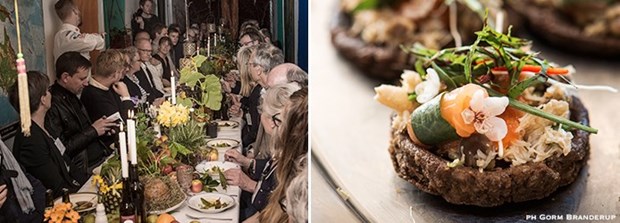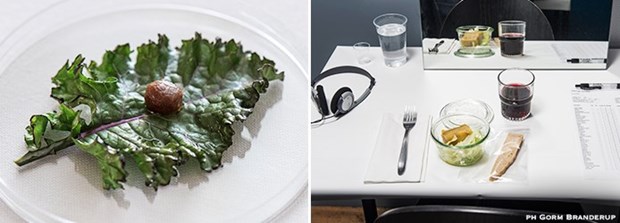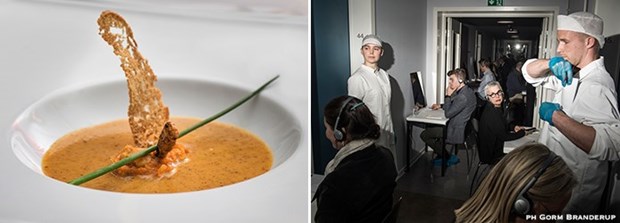What we are going to
eat in 2067 is not
only a topic for gourmets and journalists on the lookout for food trends:
questioning ourselves on what future food will be like is not only a matter of
taste, but also – and above all – survival.
Cooking
food is what sets us apart from other animals and has enabled us to evolve,
making us what we are today: what would happen if we no longer had the
possibility and lost contact with the most primitive aspects of our
relationship with food?
The
topic has been probed by eight great chefs from all over the world who,
together with scientists, artists, politicians, producers and researchers, have
staged for the very first time a social, political, economic, ecological – and
gastronomic – experiment, the likes of which has never been attempted before: The Catastrophic Meal.

A Catastrophic Meal in Copenhagen | The Table
Talks
started in February 2017 in Denmark and, on 26 April in Vestjyllands Højskole,
in the middle of the countryside, they led to the first of a series of
dinner-performances which set out to forecast two possible future developments,
of a utopian and dystopian nature. Two diametrically opposed and paradoxical
scenarios: the first was presented as an ideal model while the other was quite
frightening, to be avoided at all costs.
The
aim of this provocation – rethinking the future – is also the slogan of the
events due to take place this year in Aarhus and the Danish region of
Mid-Jutland, the European Capital of
Culture and a European Region of Gastronomy.
The future is not
what it used to be
Dinner
gets off to a start in the open air, playing with the contrasts between
synthetic tasteless calories and tamales cooked in an open fire,
tribal-fashion.
Sioux
chef Sean Sherman from Minnesota offers food foraged or hunted in the wild, in
the way his people has been doing for centuries. On a rich land, native
Americans never bred or farmed food but lived in harmony with nature, since it
was able to provide them with all they needed, as in the Garden of Eden. Each
course is conceived and cooked by a chef and served in a different setting,
installed specifically for the occasion.
Insects, not
everyone’s idea of a treat
Animal
proteins deriving from insects are a highly sustainable source of nutrients.
This is what we may end up eating in a possible future when cows, pigs and
chickens have become protected species and there is no longer sufficient land
to breed them on.
For
years now, Canadian chef Thémis has been preparing for this moment. For this occasion,
he has cooked a refined cricket bisque and some larvae-enriched bread.
It
is served to the guests, who are skeptical of this imaginary future, and only a
few of them take up this culinary challenge, knowing what is on their plate. In
the meantime, a group of actors mill around searching for food: the dinner is
not only a foodie experience but a theatre performance as well.
The end of cooking
From
one course to another, from one stage set to the next, with no more water, air
or land available, the food of the future has the mere function of fuel,
something to drink from a syringe, a sip of which contains all the nourishment
our body needs.
It
could also take the form of a lab-produced hypoallergenic tortilla, accompanied
by an “authentic” cola-based sangria to be consumed in a canteen run like a
hospital, where the consumption of food takes place in solitude, a sterile,
mechanical and tasteless experience similar to a surgical operation.

A Catastrophic Meal in Copenhagen | The Dishes
Roberto
Flore, an Italian chef engaged in the Copenhagen-based non-profit organization
Nordic Food Lab, serves up a future in which nature has no part.
Champagne
will be replaced by water and test tube food will be served in restaurants,
surrounded by stuffed animals – species that are now extinct. “In the past, man
managed to survive hunger and dire poverty – explains Roberto – we hope and
believe that it can still be done” and into the dining room comes a laboratory
slide on which there is a leaf carrying an extremely tasty drop of yellow pea
tempeh, the result of years of research.
It
is not intended to be a new gourmet ingredient for 3-star restaurants but a
source of protein for sustainably feeding the population. That of today, not
tomorrow’s.
Sharing will save us
Dining
goes hand in hand with conviviality: easily said when food abounds. In the
dystopian future imagined by The Catastrophic Meal it’s every man for himself.
During
the aperitif a few lucky people receive bigger portions than others; some of
them eat everything, only a few share with their companions.
Then
comes the next course: the “wealthy” sitting at the insect banquet taste their
bisque while the “poor” actors mill around behind them searching for food but
some minutes go by before anyone hands a morsel of bread to the needy.

A Catastrophic Meal in Copenhagen | The Guests
The
Catastrophic Meal starts out with the semblance of a dinner-event and ends up
by teaching us something new in terms of flavour. The foodie experience is a pretext
for kindling a new awareness of sharing, the only way to change the world and
experience a better present and a utopian future.
Kobus
van der Merwe from the Wolfgat restaurant in South Africa lays a sumptuous
table with horns of plenty brimming with fruit and vegetables alongside
vegetarian dishes.
We
huddle around and chat as the food is placed at the centre of the table for
sharing; we interact according to the chef’s instructions: “Put two drops of
dressing in the plate of the person sitting on your left hand side and smile”.
By Margo
Schachter/ FDL